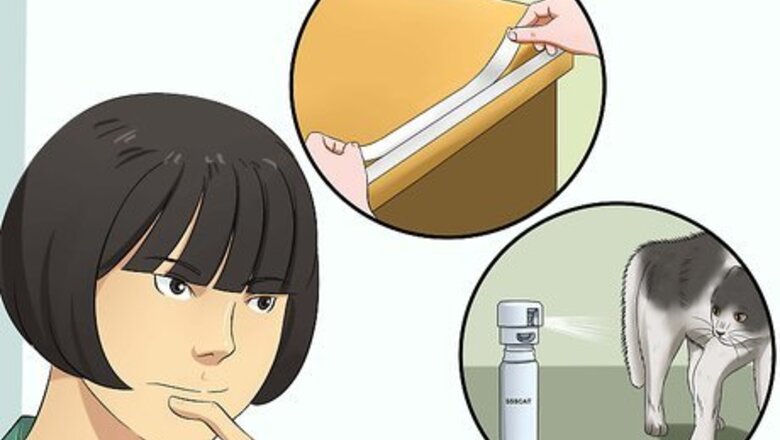
views
Using Environmental Punishers

Create your own environmental punishers. Environmental punishers—also called "remote correction"—involve disciplining the cats without being present yourself, so the cats don't link the punishment to you. If you punish your cats for jumping on off-limits surfaces yourself, they will learn to keep off counters only when you're at home. You can create some devices for remote correction yourself, but never create a deterrent that might hurt your cat(s).

Place light baking sheets at the counter's edge. This simple means of discouraging your cats from jumping on the countertop works because the cats will land on the sheets when they jump onto the counter. The noise and unexpected movement will frighten them, but not physically hurt the cats. Over time, they will associate the countertops with this sound and the stress it creates and avoid jumping up there. You can also fill baking trays with water and set them on the counter. Cats will be startled not only by the noise, but by the water as well. The drawback here is that cats can slip in the water, so if your cat is old or not especially spry, it would probably be better to avoid this method, as they might slip and hurt themselves.
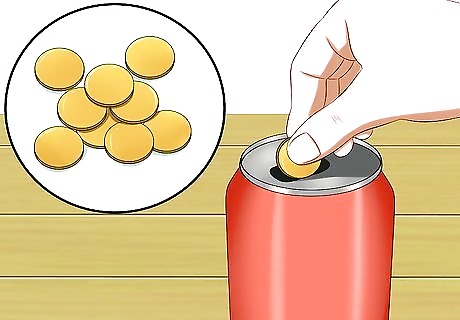
Create a noise trap. String a line of twine across the access point where your cats usually jump onto the counter. Attach one end of the string to empty cans that can be easily knocked over. If you position it just right, a cat jumping onto the counter will move the string enough to knock over the cans, creating a startling noise that will deter him or her from jumping up there again. For an even more startling noise, add coins or other small objects to the cans.
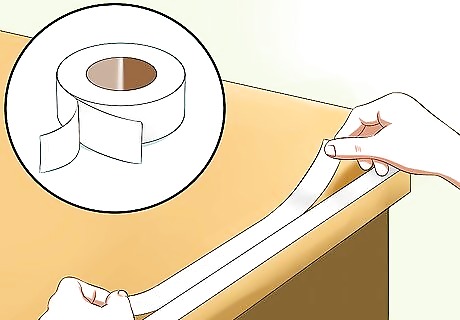
Place double-stick tape on the surface where the cat is not allowed to go. The tape can be lightly applied in just a couple of spots to hold it on, then, when the cat jumps upon it, it will stick to his or her paws, deterring them from going there again. Cats are easily distracted and annoyed by objects that stick to them, so the double-stick tape should be effective. You can also try putting aluminum foil on surfaces. The noise will deter cats should they land on it.
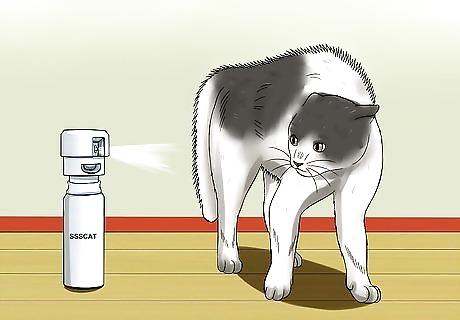
Buy devices designed for startling cats and put them on the counter. These devices startle cats with loud noises, unexpected movement, or double-sided tape. There is quite a market for these types of deterrents, so do some research to see what works. Motion-activated air blasters are one example of electronic devices meant to deter cats from countertops or other unwanted surfaces or areas. A motion sensor detects the cat in the off-limits area and immediately sprays the animal with a strong gust of air, startling them. Motion-activated alarms are another device that can help deter cats from countertops. A motion sensor activates a loud alarm that startles the cat and alerts the owner. Some motion-activated alarms are pressure sensitive, so they are activated when the cat touches them or what they are positioned under. There are even mats that are pressure sensitive that you can roll out on the countertop so they will be triggered when the cat lands on them. Silent motion-activated alarms provide a less bothersome alternative to other motion-activated alarms. These alarms emit a tone of such a high pitch that they are inaudible to humans and even dogs, but they will deter cats. Textured mats are a harmless deterrent that require no electricity, batteries, or compressed air. These mats are simply-textured with a minimally-pointed nub that is uncomfortable for the cat to tread upon. Encountering them, the cats will generally jump off.
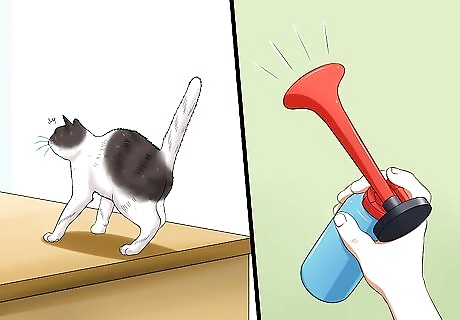
Activate noisemakers yourself. Conceal yourself from the cat's view and use a noisemaker of some kind as soon as you see the cat jump on the counter. There are many noisemakers from which to choose, and there are even some that are manufactured for this specific purpose. An air horn can be an effective way of startling the cat enough to get them off the surface from which they are banned if you can catch them in the act and remain concealed. Just be sure the air horn you choose is not so loud the you damage the cat's or you own hearing. Some manufacturers have created air horns that are loud when activated, but that also spray a pheromone which further deters the cat from unwanted behavior.
Giving Cats Alternatives
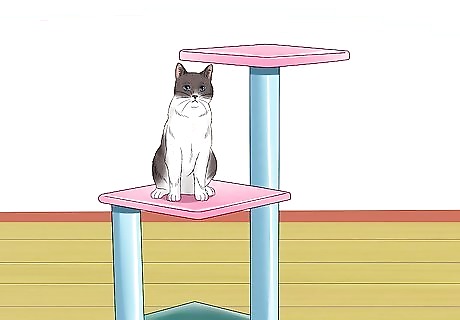
Give cats acceptable alternatives to satisfy their natural instincts to climb and jump. For instance, cats crave what veterinarians call "vertical challenges"; they will find counters less appealing if they have other objects to jump onto or climb.
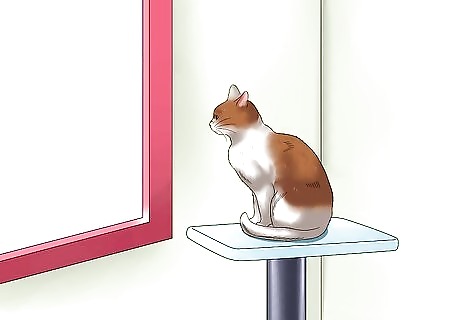
Place vertical cat furniture near windows. Cat trees, cat condos, or climbing posts give cats a place to climb, perch, and survey their surroundings. Being near the windows allows them to look at natural prey, which satisfies their curiosity and stimulates them to the point that they will be less likely to jump onto countertops and other surfaces.

Install a cat shelf. Cat shelves are padded surfaces attached to the insides of window sills. Like cat trees and other cat furniture, cat shelves satisfy curiosity while stimulating your pet at the same time. Choose windows with good sun exposure, as cats do like to lay in the sun, and the cat shelf is a great place to do so in a window that gets a lot of sunlight. The cat shelf gives your cat(s) an alternative place to sleep and/or watch what's happening outside, which can help keep them distracted from countertops.
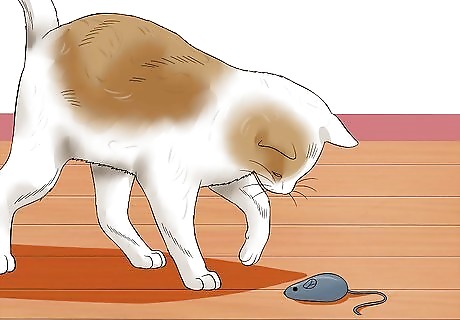
Give cats an assortment of toys to play with on the floor. These toys may help use up their energy so they will be less inclined to jump on counters. If you can keep your cat interested enough in toys that stay on the floor in particular, you may also be able to keep them from becoming interested in jumping onto countertops. Change the available toys occasionally so they don't get bored and start jumping on counters for new stimulation. Many cats like simple toys, like small, fake mice that you can throw across the room for them to chase—they may even bring them back to you! Some cats will inevitably avoid expensive toys and play instead with empty plastic bags, boxes, laundry baskets, etc. Experiment with different types of toys to see what you cat likes before you buy an expensive toy. Many cat toys are now electronic, with toy mice that run around a track or even ones with wheels so they can roll across carpeting or other floors on their own. Still other toys incorporate LED lights and other technology. These toys can be very stimulating for cats, thereby keeping them off off-limits surfaces like countertops.

Provide a variety of cat beds in warm, sunny sites inside your home. Cats particularly enjoy beds in which they can "nest" or burrow. Cats sleep 16-20 hours per day, which is a lot of time they won't be interested in jumping on countertops. If you give them especially inviting spaces in which to sleep, you'll be encouraging them to sleep in these spaces and not on countertops. You'll also be helping to ensure they are taking full advantage of sleeping time and not seeking out new stimulation around the house—such as on the countertops.
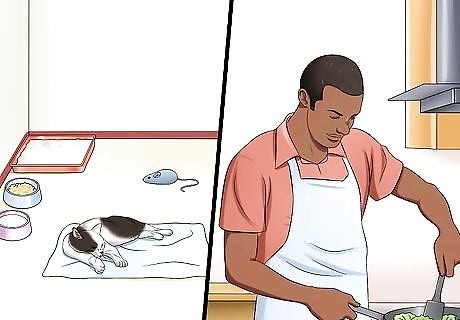
Put your cats in another room while you're cooking. This is so they don't become curious about what is on the counter from the smell of food coming from there. Cats' sense of smell is forty times stronger than that of humans. They will smell whatever you are cooking, and this can excite their sense of curiosity when you're not around, so they may jump onto the surface these smells emanate from. Cats might even have trouble controlling their curiosity and jump on the counter even while you are actively cooking. Putting cats in another room while you cook can minimize their curiosity about countertops and help keep them from jumping there. Be sure to provide a toy and comfortable place to sleep in whatever space you leave them while using the kitchen to cook or prepare meals so they are stimulated and comfortable. Confining cats to another room while you're cooking doesn't work with all cats, so don't be surprised if your cat whines from inside the room. If this happens, try not to leave them in there too long or you may cause them stress. Your cat may jump on the counter because it wants to spend more time with you, so be sure you have quality bonding time with it other times during the day.
Making Counters Less Tempting
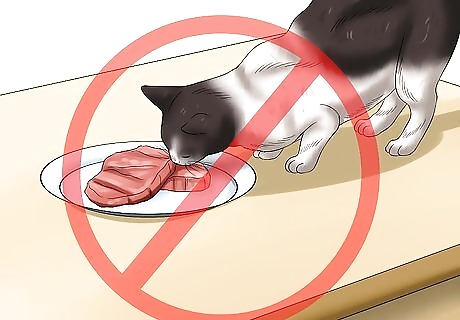
Keep counters clear of human food which may tempt your cats. Again, cats have a very powerful sense of smell, so food particles left on countertops can lure them into trying to find and eat any scraps, crumbs, or spills you may have missed, in addition to clawing or biting their way into food you have stored on countertops. If you must store food on counters, place it in containers which cats can't tear or chew open.
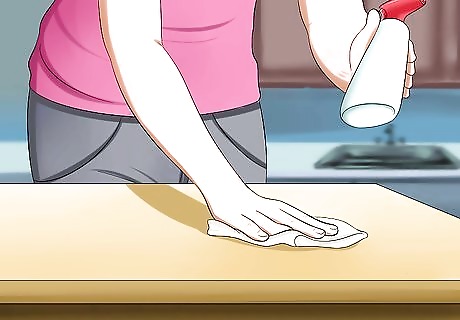
Wipe off counters frequently. This eliminates the odor of food on the surfaces. It might be especially effective to wipe off counters with a disinfecting wipe, which will eliminate odors that may attract your cat while keeping your countertops clean and sanitary. Choose cleaners or disinfectants that smell like citrus, aloe, eucalyptus, or wintergreen in particular. These scents will deter cats from unwanted surfaces. In fact, many perfumes will have the same effect.
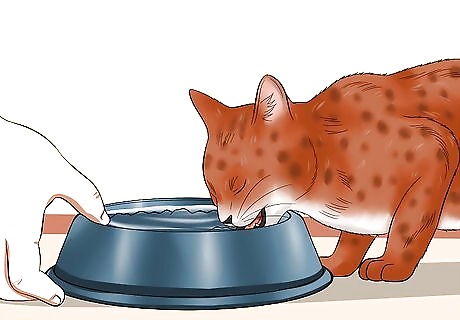
Consider giving more food to your cats. It is possible your cat is jumping on your countertops to scavenge for food because he or she is hungry. You might be able to determine if this is the case simply by offering your cat more food than usual. If the cat doesn't seem to jump on the counter after you start offering more food than before, then you might have solved the problem. However, some cats do overeat, and even if you do offer more food, they may still jump onto counters. Be prepared for this possibility as you try offering more food to combat countertop incursions. Feed your cats more frequent meals. Many cats are "grazers" meaning they like to eat small amounts of food over the course of the day instead of having specific mealtimes where they eat a lot of food at once. If your cats are grazers, feed them small, frequent meals throughout the day. Just be sure you don't exceed the daily serving amount on the food package (unless your veterinarian instructs you to do otherwise). Watch your cat's eating habits and weight to prevent obesity if you alter their regular feeding routine.

Keep counters free of objects cats like to play with. If you have cats toys or other objects cats like to play with on the countertop, then the cat will be tempted to jump up there and get them. Keep in mind that cats toys are not the only things cats like to play with. Your cat may be tempted to get on countertops to play with objects like keys, pens, lip balm tubes, and paper. Keep in mind also that you should not store cat toys in a location near the countertop, such as a cabinet. If the cat sees you put a toy there, he or she may be more likely to get on countertops to try to get the toy.

Keep windows near countertops covered. Be sure you close the curtains or shades on windows that your cat can access via the countertop. Cats like to look out windows to see birds, chipmunks, and other wildlife outside, so they may jump on countertops to get to those windows. This is why it is a good idea to have cat trees or cat shelves set up for cats to be able to look out windows (see Method 2).
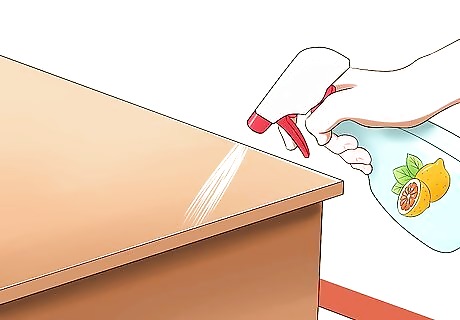
Clean your counters with lemon pledge or lemon oil. Cats don't like lemon, so this might work on your cat(s).



















Comments
0 comment